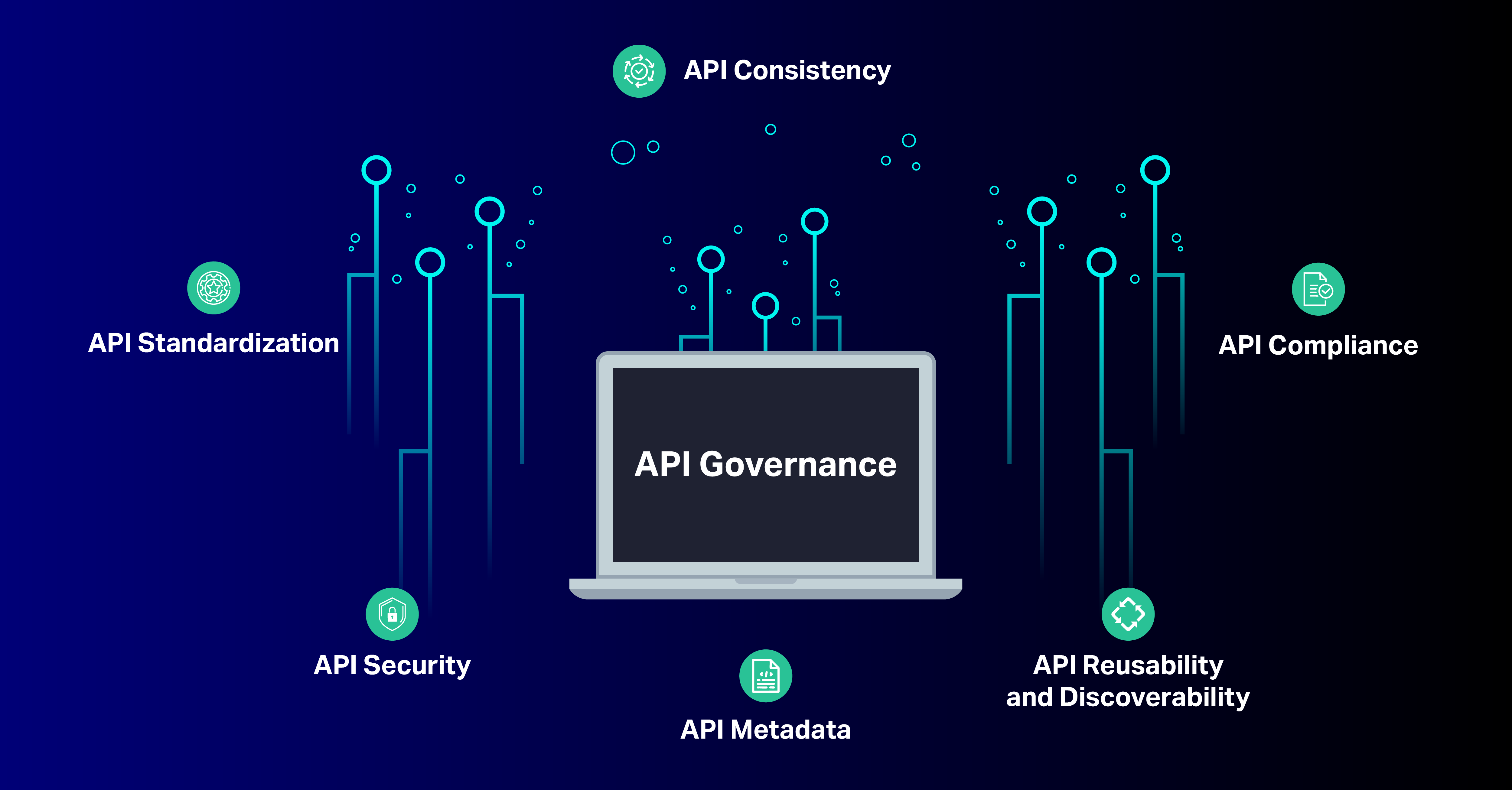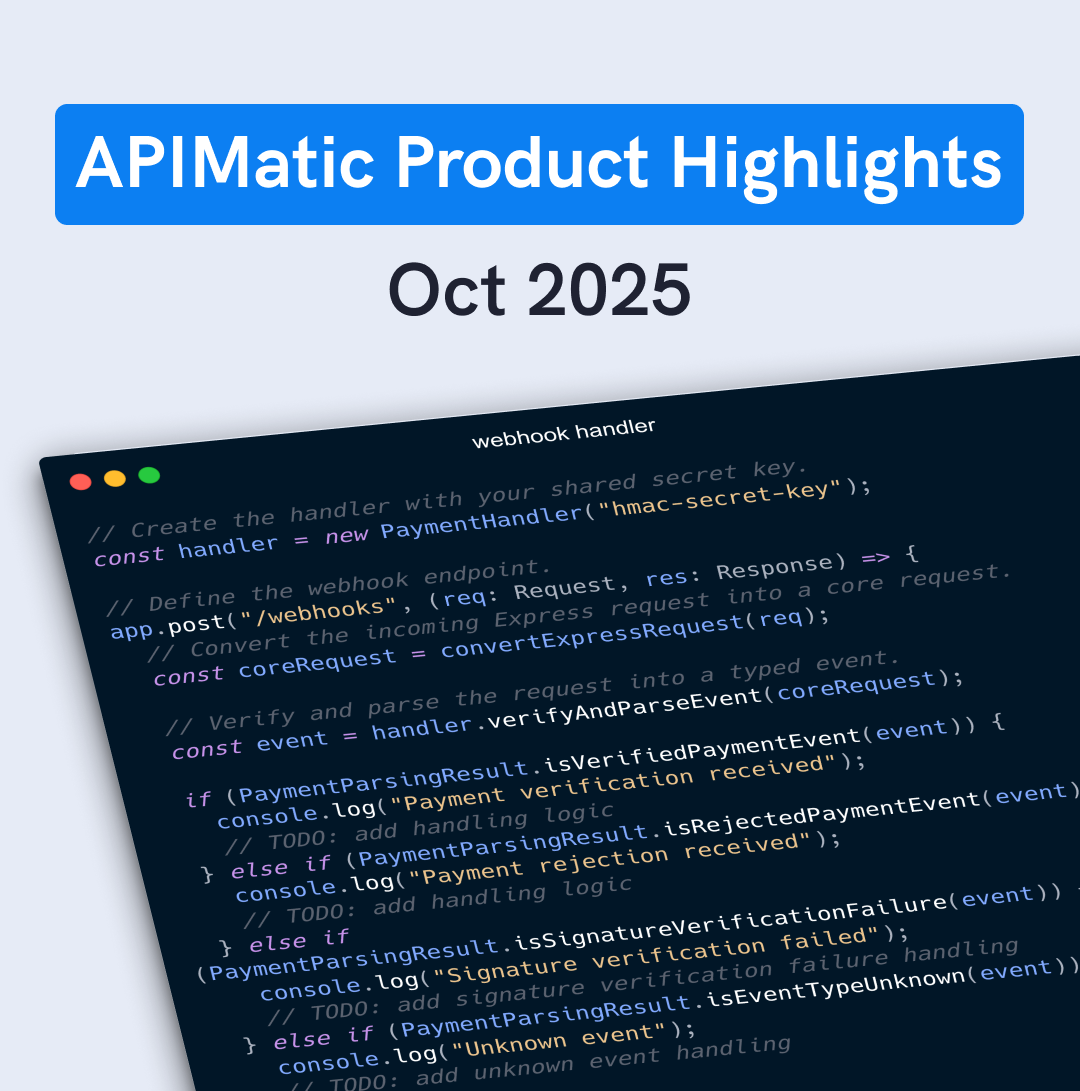API governance is the linchpin of successful digital transformation. In this article, we cover the top five takeaways from API experts, including establishing strong schema foundations, leveraging OpenAPI for standardized APIs, balancing centralized and federated models, implementing automated linting for quality assurance, and aligning API governance with business goals for measurable impact.
 We’re APIMatic.io. We generate strongly typed SDKs and complete API documentation from OpenAPI definitions. If you want to create an SDK for your REST API, check out how to generate one in under a minute. We support generating SDKs for C#, Java, PHP, TypeScript, Python, Ruby, and Go using the APIMatic Code Generator.
We’re APIMatic.io. We generate strongly typed SDKs and complete API documentation from OpenAPI definitions. If you want to create an SDK for your REST API, check out how to generate one in under a minute. We support generating SDKs for C#, Java, PHP, TypeScript, Python, Ruby, and Go using the APIMatic Code Generator.
The Foundation: Starting with Schema
Kin Lane aptly emphasizes that "API governance begins with schema, particularly JSON schema." This foundational layer is ubiquitous across enterprises, serving as the bedrock for API operations and governance. Focusing on REST APIs, which constitute 50-80% of enterprise traffic, allows organizations to establish a solid base before venturing into more specialized areas.
Understanding the Multifaceted Landscape
Effective API governance requires a holistic understanding of diverse perspectives: API producers, consumers, and service providers. Each stakeholder plays a crucial role, and their needs must be considered. Moreover, organizations must navigate the complexities of design-first versus code-first approaches for APIs.
The Power of OpenAPI Specification
The Open API Specification (OAS) is a cornerstone of modern API governance. It provides a standardized way to describe APIs, enabling automated tooling, documentation, SDKs, and policy enforcement. By embracing OAS, organizations can streamline governance processes and foster consistency across their API ecosystem.
Centralization vs. Federation
One of the most debated aspects of API governance is the balance between centralization and federation. Kin Lane suggests starting with a centralized approach, allowing for initial control and standardization. As the organization matures, a federated model can be gradually implemented, empowering teams while maintaining overall governance. This aligns with the increasing complexity of API ecosystems in large organizations, especially those with global or multi-cloud environments. The key benefits of federated API management are decentralized governance, better scalability, optimization for hybrid/multi-cloud, and the ability to customize for different needs. However, it's vital to begin with a strong, central foundation and iterate from there.
Enforcing Rules and Standards
Implementing rules through tools like Spectral, Vacuum, and APIMatic is essential for linting APIs and schemas. These tools automate checks for adherence to standards, ensuring consistency and quality. Teams benefit from automated checks and tooling, reducing reliance on manual processes and minimizing human error.
Fix My OpenAPI is an APIMatic initiative that optimizes API definitions for SDKs and API portal generation, with over 400+ out-of-the-box linting checks. It is a free tool that identifies the problems and automatically fixes common API issues, saving time and effort in manual troubleshooting.
Beyond Technical Governance
API governance extends beyond technical considerations; it encompasses business aspects as well. As James Higginbotham highlights, API governance should align with business goals, serving as a framework of policies, processes, and procedures that drive organizational objectives.
Managing Change and Fostering Evangelism
Effective change management is critical for successful API governance. This includes robust versioning strategies and clear communication channels. Moreover, evangelism is pivotal in promoting governance practices internally and externally. As Kin Lane suggests, evangelism should be a shared responsibility, fostering a culture of API excellence.
API Governance vs. Agility
A common misconception is that API governance stifles agility. However, governance is not necessarily a constraint on creativity and innovation. When implemented well, it can enable more agile development and experimentation by ensuring reliability and consistency. Effective governance should be nimble, easily understandable, and easy to follow, measure, and report on. It's an ongoing process that should be reviewed and updated regularly. Organizations can start small with governance and mature over time rather than trying to implement a comprehensive system all at once.
API Governance vs. Developer Autonomy
Developer autonomy is essential for innovation, but excessive independence can lead to API sprawl and a lack of standardization. API governance provides the necessary guardrails without stifling creativity. It is essential to balance these two seemingly conflicting forces. Specification-driven development provides a way to improve API governance, promoting better communication between technical and business stakeholders. This approach fosters collaboration and ensures that APIs align with business needs.
API Governance as a Survival Guide
James Higginbotham emphasizes that API governance defines organizational values, acts as a force multiplier for API providers and consumers, and creates coaching and career growth opportunities. Higginbotham's five recommendations for transformational API programs provide a roadmap for organizations seeking to elevate their API governance practices:
- Align API platform with business architecture and digital ecosystems: Combine IT and business capabilities, express business as APIs, and consider different digital ecosystems.
- Foster community engagement, offer office hours, provide coaching, and facilitate design sessions.
- Implement a Federated API Coach program to scale governance efforts and provide domain expertise.
- Recognize shared governance needs across data, security, AI, and other domains.
- Establish expectations and provide a decision framework.
Measuring the ROI of API Governance
Measuring the ROI of API governance can be challenging, but metrics like reduction in broken client integrations and improved development productivity can demonstrate its value. Relating governance to higher-level business outcomes is crucial for demonstrating its impact on the organization's bottom line.
The Future of API Governance
The future of API governance points towards the growing adoption of decentralized architectures and the evolution of API standards. AI is poised to play a significant role in API governance, particularly in documentation, technical debt management, and API discovery.
However, organizations must exercise caution and establish clear AI policies, ensuring that AI governance aligns with API governance best practices.
Conclusion
Ready to ensure your APIs meet the highest standards? Take the next step in your API governance journey. Check out APIMatic’s Score My OpenAPI tool, or our VSCode and GitHub App, to effortlessly lint and validate your OpenAPI specifications. Streamline your API development process and guarantee consistency today!





